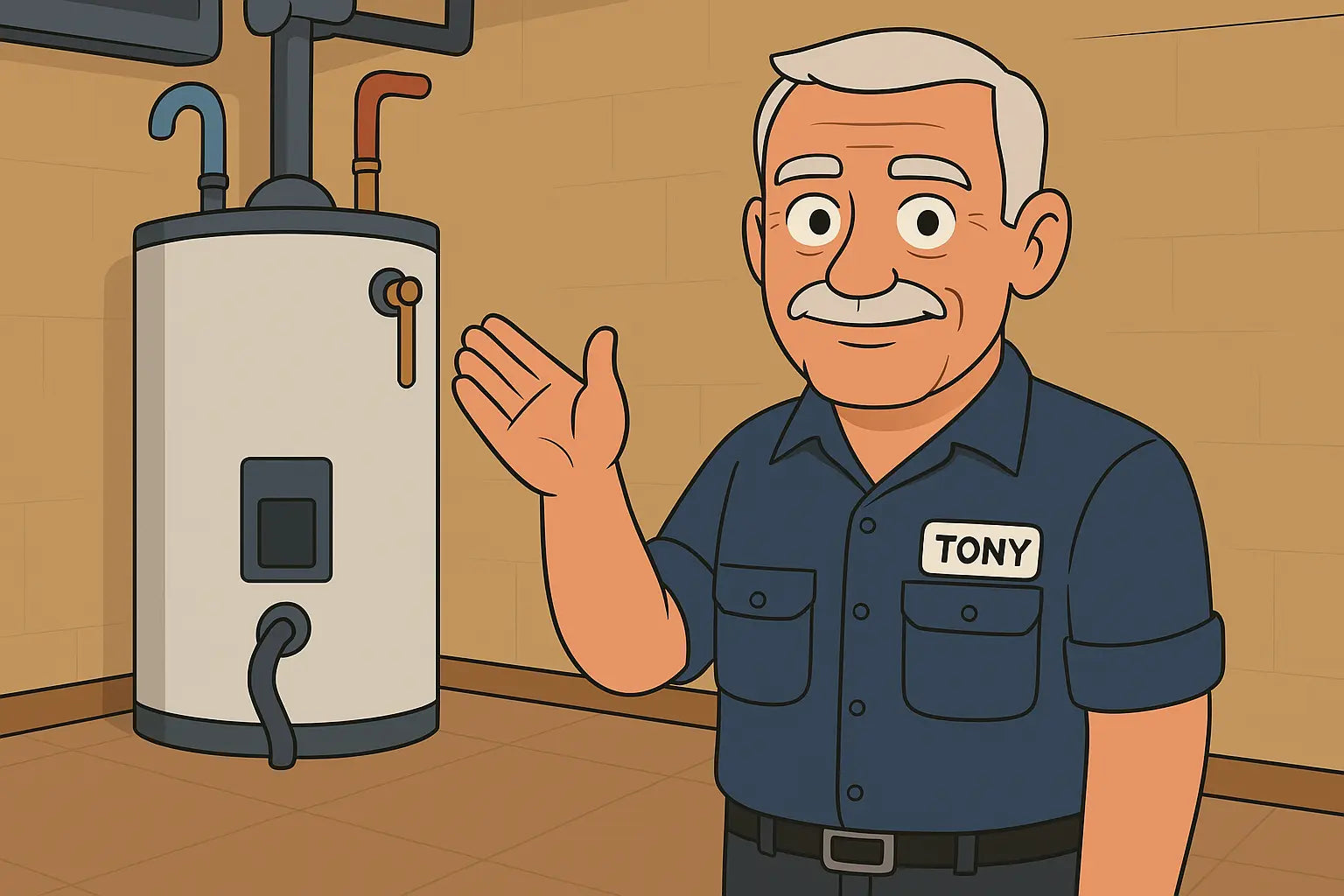Hey there, it’s Tony.
You know what grinds my gears? When someone drops a grand or more on a brand-new water heater, then wires it wrong and cooks it before they even get a warm shower out of the deal. Seen it too many times. So today, I’m gonna walk you through the biggest electrical mistakes folks make when installing 50–60 gallon electric water heaters. Some are honest blunders. Others? Just flat-out ignoring the manual. Let’s fix that. 🔧⚡
1. Using the Wrong Voltage or Breaker Size
Your water heater isn’t a toaster. It pulls a serious amount of juice, and it expects the right voltage and circuit breaker size. Most 50–60 gallon electric heaters need 240 volts and a 30-amp double-pole breaker—not 120V and definitely not plugged into your garage outlet.
Too small a breaker? It'll trip constantly.
Too big? The wiring may melt before the breaker trips. Boom. That’s a fire hazard.
Don’t guess. Always check the rating plate on the unit and match the ampacity of the breaker to the element wattage. Here’s a solid guide from The Spruce on circuit requirements for water heaters if you want backup.
2. Skipping the Disconnect Switch
I get it. You want to be done and back to watching the game. But not adding a disconnect switch between your breaker panel and the unit? That’s a code violation in most places, and a safety issue everywhere.
It allows for fast shutoff in emergencies or while doing maintenance—so you’re not running back and forth to the panel like you’re training for a marathon.
NEC requires it in some configurations, and your local inspector probably does too. Mike Holt’s forum is full of electricians who’ll back me up on that.
3. Failing to Ground the Unit Properly
Your water heater is metal, wet, and full of electricity. Not grounding it correctly is asking for shocks, shorts, and corrosion. Always:
-
Use a proper grounding conductor
-
Connect it to the green screw or terminal on the unit
-
Bond metal water pipes (if used)
4. Using Undersized Wiring
Here’s a quick rule: a 30-amp breaker needs 10-gauge wire minimum. Don’t try to get away with 12-gauge wire just because it’s what you’ve got laying around. That’s not just bad practice—it’s dangerous.
Why? Thin wire can overheat under load, especially during those long cycles when your tank is reheating a full 60 gallons of water. Worst case? It catches fire inside your wall and you don’t even see it until your drywall’s glowing.
Always check your wire against the NEC’s ampacity chart or use Southwire’s online calculator to match distance, load, and wire gauge.
5. No Strain Relief or Cable Clamp
When you run your wiring through the knockout in the unit, you need a clamp or strain relief to protect the cable from sharp edges and keep it from pulling loose over time.
This one’s basic, but a lot of DIYers skip it and end up with frayed conductors or loose connections later down the line. That’s a recipe for arcing and eventual failure—or worse, an electrical fire.
6. Loose or Over-Torqued Connections
Let’s talk about lugs and terminal screws. You want ‘em tight—but not gorilla-tight. Over-torquing can crack terminals or strip threads. Under-torquing? That’s worse—leads to arcing, heat buildup, and burnt connections.
Use a torque screwdriver if you’ve got one. If not, firm hand-tight with no wobble. And always double-check every connection after the first heat cycle.
Here’s a helpful visual guide on wire terminations from ADPTraining that’s worth the read.
7. Mixing Up Line and Load
This one’s a silent killer. If you mix up the line and load wires, your heater might seem to run fine... until it doesn’t. Elements can overheat, thermostats won’t work right, and your safety systems can get bypassed.
Color code your wires properly and label each line if you’re unsure. On a 240V circuit, both hot wires are usually black and red. Ground is green or bare copper. Don’t guess—verify with a multimeter.
8. Ignoring Local Electrical Code
Every state—and sometimes even cities—has its own rules on water heater installs. Some want GFCI protection, others require AFCI breakers. Some allow Romex, others want conduit.
Do yourself a favor and check in with your local AHJ (Authority Having Jurisdiction) before you run that wire. A quick call can save you hundreds of dollars in rework later.
For a general overview of codes, this NEC cheat sheet is a great place to start.
Tony’s Troubleshooting Pro Tips 🔎
If your unit’s already acting weird, here’s what to check:
-
No power? Start at the panel—verify the breaker is on and delivering 240V.
-
Tripping breaker? Check for shorted elements or loose wires.
-
Only lukewarm water? Your wiring might be feeding only one element.
Grab a multimeter and a healthy dose of patience. And if sparks fly? Call in a pro.
Final Word from Tony 🧰
Alright, friend — we’ve covered a lot. Whether your water heater’s acting up or you’re eyeing a fresh install in a tight spot, remember this: a 50–60 gallon electric water heater is a workhorse, but only if it's installed right and wired smart. Skimping on proper installation or ignoring electrical hiccups can take years off its life — and jack up your energy bills.
My advice? Take your time, double-check every connection, and don’t be shy about calling in a pro if you feel even a little out of your depth. It’s not just about hot water — it’s about peace of mind.
And if you're looking to upgrade or replace your current unit, I recommend starting with this lineup of reliable, no-fuss models right here:
👉 50–60 Gallon Electric Water Heaters at The Furnace Outlet
Need more installation and troubleshooting tips for your 50-60 gallon water heater? Visit my guide right here!
Stay safe, stay sharp, and may your showers always be hot.
— Tony the Trusted Tech 🔧







